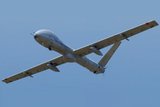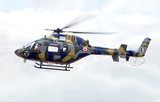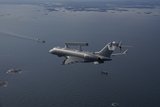BAE Systems wins $4 million in DARPA cash for AI programme
BAE Systems intends to solve the speed and data volume problems of AI air combat. (Photo: BAE Systems)
DARPA, the Defense Advanced Research Projects Agency, has awarded BAE Systems’ FAST LabsTM research organisation a US$4 million contract for Phase 1 of its Artificial Intelligence Reinforcements (AIR) programme.
The AIR programme was devised with the intention of advancing dominant tactical autonomy in beyond-line-of-sight and beyond-visual-range air combat missions. Given the relative ubiquity of the aircraft in combat situations, the potential autonomy solutions devised by the AIR programme will be developed on F-16 testbeds.
Autonomy is frequently challenging, but delivering autonomy in the rapidly changing reality of fighter jet combat environments has proven especially difficult to deliver, primarily because of the potential for constantly changing four-dimensional data – all of which needs processing at speed and translating into combat action.
Related Articles
AI proves its mettle in AlphaDogfight
DARPA’s Air Combat Evolution programme (ACE) helped advance the science of fighter jet autonomy, running the first “Human vs AI” dogfight to take place in real airspace in 2023. That too was based on the characteristics of F-16 air combat, with a modified F-16 known as the X-62A or VISTA.
The goal of the ACE programme was to raise and predict human trust in autonomous flight systems in combat situations, although the position of armed forces around the world currently remains wedded to human-in-the-loop models.
The AIR programme takes the ACE goal further towards actively AI-supported or even AI-piloted fighter jets, by solving the problems of data processing, decision-making and combat action within the timeframe of traditionally human-piloted aircraft.
If DARPA can deliver the dominant tactical autonomy for which the AIR programme will strive, it will underline US and US-ally supremacy in the air.
BAE Systems said it will use machine learning (ML) to innovate simulation models of existing sensors, electronic warfare systems, and weapons within dynamic and operationally representative environments. ML techniques will also capture the underlying physics of aerial manoeuvres and systems.
Michael Planer, principal investigator at BAE Systems’ FAST Labs, summarised the approach the company would take to the AIR programme goals.
“Generating reliable, consistent air combat performance requires a vast amount of data and rapid, robust testing cycles,” Planer remarked. “Using ML, we will train the models used to make dynamic decisions, ensuring that the AI pilot is tested and trusted by human pilots.”
More from Air Warfare
-
![Singapore’s Hermes 900 buy to enhance multi-domain ISR capabilities]()
Singapore’s Hermes 900 buy to enhance multi-domain ISR capabilities
Drawing on its endurance and substantial payload capacity, the Hermes 900 would provide a boost to Singapore’s ISR capabilities, particularly in the maritime domain.
-
![Dubai Airshow 2025: GA-ASI’s MQ-9B racks up new milestones with AEW demo planned]()
Dubai Airshow 2025: GA-ASI’s MQ-9B racks up new milestones with AEW demo planned
The company announced its demonstration timeline while confirming the MQ-9B had completed the platform’s third lifetime test.
-
![Dubai Airshow 2025: Edge Group eyes international market expansion, unveils new UAVs]()
Dubai Airshow 2025: Edge Group eyes international market expansion, unveils new UAVs
The UAV portfolio expansion comes in the wake of the Edge-Anduril joint venture announced ahead of the airshow.
-
![India reopens hunt for reconnaissance and surveillance helicopters]()
India reopens hunt for reconnaissance and surveillance helicopters
The extended deadline for vendors highlights the complexity of the procurement for India, with numerous vendors positioning themselves for the programme.
-
![European firms express interest in filling NATO airborne early warning replacement needs]()
European firms express interest in filling NATO airborne early warning replacement needs
The comments from both Saab and Airbus on their potential to fulfil the airborne early warning and control requirement come after NATO countries shelved plans to procure six E-7 Wedgetail AEW&C aircraft.
-
![Dubai Airshow 2025: Lockheed’s AGM-158 XR flight tests planned for 2026]()
Dubai Airshow 2025: Lockheed’s AGM-158 XR flight tests planned for 2026
The AGM-158 XR, which started as a Lockheed Martin internal investment, was first unveiled in September 2024.























